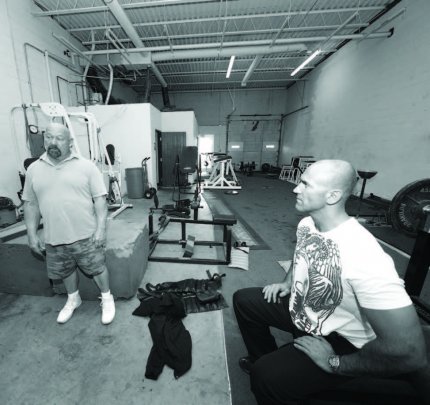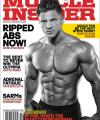Welcome To Westside

An in-depth interview with Westside Barbell owner and powerlifting icon Louie Simmons!
For the better part of 30 years, Westside Barbell in Grove city, ohio, has been seen by many experts as ground zero for a subculture of giant men and mammoth lifting. Its owner, louie simmons, has been a pioneer in maximizing the strength and power of sports athletes. Himself a champion, simmons has made “Westside training” synonymous with platform success (and controversy). His gym membership, past and present, boasts dozens of names seen routinely in the record books. Future legends. It’s a place where weakness is beaten out and replaced with the kind of bone-crushing strength that leaves folks in awe.
Welcome Mr. Louie Simmons…
ROB “FORTRESS” FORTNEY:
Westside Barbell was originally a gym on the west coast, right?
LOUIE SIMMONS:
The original Westside Barbell was in Culver City, California.
FORTRESS:
You had nothing to do with that gym?
LOUIE:
No. I wanted to visit but never got there. I had friends who did, and I knew it was the real deal, because they made so much progress. That original location was there from the mid-‘60s to about 1970. At that time, I was just a beginner.
FORTRESS:
When you opened your Westside Barbell, were there any legalities in taking the name?
LOUIE:
They didn’t own it. I now do.
FORTRESS:
So it was just your wanting to continue the legacy of the original Westside Barbell?
LOUIE:
Exactly. Those guys were the most scientific and advanced at the time, and we’re the same, today. We have been since 1983; actually, we’ve been advertised as Westside Barbell since 1985/6. Our science left everyone in the dust.

FORTRESS:
You’re in a new location. The one before—in the strip plaza—was that the original?
LOUIE:
No. It started in my basement, moved to my garage, and then outgrew those locations to the point where we had to move into buildings. Now we’re in 3,600 feet. Totally private. No sign.
FORTRESS:
Besides the larger space, what changes, if any, have been made?
LOUIE:
It’s still invite-only. I’ve worked with football players, trained two Olympic gold-medal sprinters, and worked with a UFC heavyweight champion.
FORTRESS:
What stipulations do you have for those who do train at Westside?
LOUIE:
You’re brought in on a trial basis. If you don’t get extremely strong and make constant progress, you have to leave. We just don’t need you. It’s like a team. I pay for everything. You’re rewarded with sponsorship, supplements, and so forth.
FORTRESS:
How is one considered for invitation?
LOUIE:
By careful selection. To take a beginner and help him achieve Elite status isn’t my goal. We want world records.

FORTRESS:
How did you get involved in weight training?
LOUIE:
I always wanted to be strong. As a youth, I got into a lot of trouble, so I began lifting in an attempt to stay out of it. I became more serious at 14 and entered my first power meet in 1968 before being drafted into the army. I realized powerlifting was my sport because powerlifters are five times stronger than Olympic weightlifters.
FORTRESS:
What are some of your best lifts?
LOUIE:
A 920 squat at 235, a 722 deadlift in the 220s, and a 2100-pound total at 52 years old. At 52, I had the thirdbest squat in the world and the fourth-best total. At 54, I was ranked sixth in the bench press. I totaled my first Elite in 1973.
FORTRESS:
Is powerlifting the purest expression of strength?
LOUIE:
Powerlifters must possess explosive strength, speed strength, strength endurance, high work capacity … it’s exercise specificity.
FORTRESS:
Do you follow Olympic weightlifting?
LOUIE:
I’m a big fan. It’s just not very good in America because we don’t have the coaching.
FORTRESS:
What’s the biggest difference between powerlifting training and weightlifting training?
LOUIE:
Powerlifting is much more innovative and scientific. In 1983, I was the first to implement old Soviet weightlifting methods. They have rubber plates, and that’s about it. We have all sorts of different things, such as bands, chains, different bars, etc.
FORTRESS:
What’s the greatest mistake made by those who want to become stronger?
LOUIE:
Not having a solid background. A pyramid is only as tall as its base. You also need good training partners and someone who can teach you. People do what they like, not what they need. We primarily work exercises that we get the most out of, not ones that get the most out of us. It also needs to be said that most drug-free trainers overtrain. It comes down to recuperation. They handle heavier weights than we do, percentagewise, but they can’t train as we do, because they can’t recover. Train smarter, not harder.

FORTRESS:
You guys are renowned for your use of the box squat. Do you think it lends itself more to those who do equipped lifting?
LOUIE:
Not at all.
FORTRESS:
Tell us a little about the Westside method.
LOUIE:
We do dynamic days for speed strength and max-effort days for maximal strength. You can do an extreme workout every 72 hours. Most of my guys train twice a day. You can do small workouts every 12 to 24 hours. Powerlifting and weightlifting are based on physics, mathematics, and biomechanics.
FORTRESS:
Tell us about support gear and its evolution.
LOUIE:
Squat suits came out around 1976. They gave you an extra 20 pounds. It was more like a uniform. Knee wraps gave you more added poundage. Then Ernie Frantz came out with a canvas suit in the mid-‘90s, and it was allowed in only one federation. And if you had a strong back, you could lift an extra couple of hundred pounds. Bench press shirts came out in about 1984. The original intent of the equipment was injury prevention.
FORTRESS:
What of the arguments between those who lift using support gear and those who do not?
LOUIE:
In my opinion, people who don’t wear gear have no opinion. Lifters who break records with gear and then train without are always stronger. Our top benchers use a shirt once a month. We never put the straps up on our suits and never wear knee wraps.
FORTRESS:
Will powerlifting ever see Olympic inclusion?
LOUIE:
Of course not. And I couldn’t care less. It’s a drug issue. All these [mainstream] athletes are on drugs and say they’re not. Besides, we have no marketing.
FORTRESS:
What’s your opinion on drug use in sport?
LOUIE:
I think people should take anabolic steroids if they want to.
FORTRESS:
Powerlifting is unique in that people can be very successful at an age that in most sports would be considered over the hill. I mean, you’re 62!
LOUIE:
As long as you stay injury-free, yes. You should get smarter as you get older. When I was 52, I had the fourth top total.

FORTRESS:
What predictions do you have for the immediate future of the sport, whether it be numbers, trends, etc.?
LOUIE:
The support gear has been pretty much standardized since 2000. So guys simply have to get stronger. Young guys have to learn how to get stronger without the equipment.
FORTRESS:
Is powerlifting-style training advantageous for the average exerciser?
LOUIE:
Without question. Powerlifting is just basic bodybuilding.

